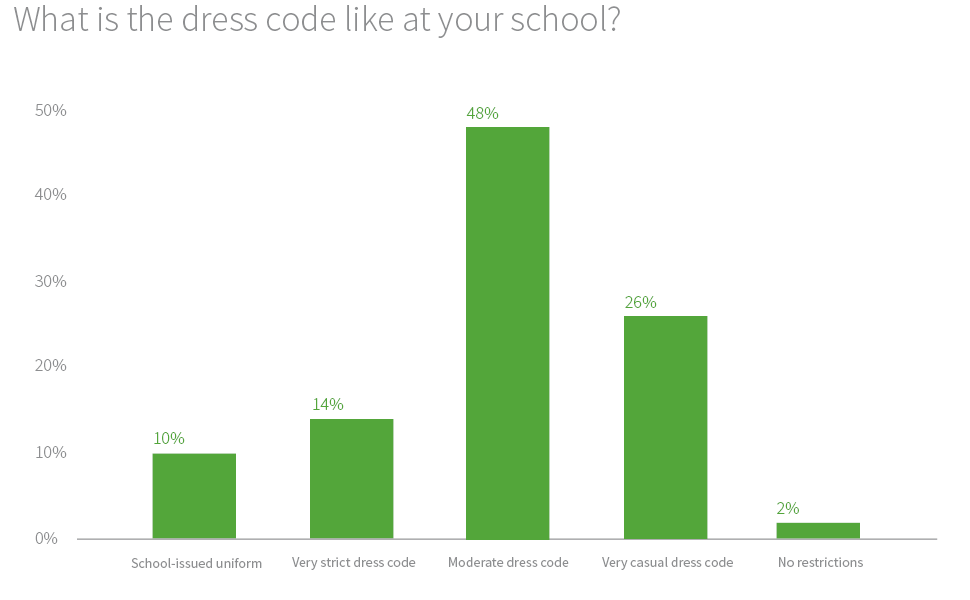[dropcap]L[/dropcap]ucy Dunne, a young plus sized girl, was in a fitting room in her favorite store when she was told by a saleswoman that the store wouldn’t carry clothing in a size “that big”. As Lucy tells The Warm Up, she was very rudely told that their clothes were more suited for “slim figures”. Sadly, this wasn’t the first time she had been body shamed.
Those words scarred Lucy and have stayed with her ever since that experience. On the bright side, she was able to use those words to inspire her to lose over 65 pounds and maintain a healthy weight.
Most teenage girls experience something close to Lucy’s experience which almost always happens in schools. Most schools implement dress codes or school uniforms which are a large contributor to girls feeling ashamed of themselves. Dress codes are dangerous because the schools don’t see that they end up discriminating, oppressing and body shaming girls, who are their main target.
Expression
The First Amendment guarantees our right to free expression, but each state can make its own laws about dress codes and what you can look like. If the state allows dress codes to be implemented, most schools use them as a way to assert control.

Graph made by Niche.com
By enforcing dress codes, schools restrict their students’ ability to express themselves. Most schools have creative classes like music programs, art programs or shop classes that allow students to express themselves. They expect students to fall under one of these and be content with the level of which they can express themselves. This obviously doesn’t work because some teens might be more passionate about makeup or fashion which schools aren’t accepting.
As seen in the graph above, Niche recorded that out of 135,000 users who submitted an answer, only 2% reported that their schools don’t use dress codes. This means almost every teen in the US is creatively suppressed in some way.
Even worse than restrictions on clothing is assigned uniforms which 10% of schools use. It is believed that uniforms help eliminate discrimination and bullying in the school environment but in contrast they restrict self-expression.
We live in a dynamic society, full of unique people. Cutting off expression outlets at such a young age only stifles creativity and encourages conformity. We want to encourage our children to be expressive and to think outside the box but forcing them to wear ugly gray sweater vests and starched white shirts is not the way to do that. Uniforms cut out much of the students’ creativity and by teaching them this conformity so early in life they will grow to be a generation of unsatisfied drones.
[perfectpullquote align=”right” bordertop=”false” cite=”” link=”” color=”” class=”” size=””]Gender guidelines pose big problems for the acceptance of the LGBT community within schools[/perfectpullquote]
Gender-specific uniform guidelines also reinforce the gender binary in the schools’ environments and increase the separation between males and females. Such gender guidelines pose big problems for the acceptance of the LGBT community within schools. They allow girls to wear uniform pants, but conflict would arise if a boy wanted to wear the specified female attire. Individuals need to be able to express themselves whether it conforms to gender stereotypes or not. Uniforms make it almost impossible for a young person to find themselves by shutting down any outlet of expression they had.
Racism
In addition to LGBT discrimination, dress codes discriminate racially. This post from Twitter reveals a young Black girl being expelled for having “unnatural hair” even though it is part of her culture and traditions.
https://twitter.com/shaunking/status/1031823052554858496
Schools don’t realize that each student might come from a different cultural and racial background. Therefore they should not have to dress to satisfy the white cultural majority.
Education Week‘s article exposes that African American girls are 5.5 times more likely than their white counterparts to be suspended from school over hair and dress codes that leave their culture out.
Adrienne Dixson, a professor of education policy, organization, and leadership at the University of Illinois at Urbana-Champaign states girls of color are more likely to wear braids, extensions or afros, pertaining to their culture, and are therefore more likely to be disciplined for it. They are teaching black girls that their cultural traditions are unacceptable in white society only worsening America’s progress on racial equality.
How are they good?
It is truly believed by many that restrictions on how students can dress at school are beneficial to their future.
The Christian Science Monitor‘s article explains, “The goal of most dress codes is to discourage inappropriate dress and cut down on distractions in the classroom”. Obviously, schools want to encourage learning and make it as easy as possible to focus.
It’s important to realize that a school is a public place where respecting others is expected and getting an education is the main focus. Obviously, walking around in a swimsuit is a little unreasonable but some restrictions go a little too far.
School administrators include dress codes to keep students from wearing anything offensive, violent or exposing which very effectively improves the overall learning environment. Their aim is to ready teens for the real world where more respect is required, especially in the workplace. Without dress rules in school teens would grow up not understanding the idea of formality and respectful dress in a mature society.
Although, they would be happier with their self-expression.
Sandusky Register explains that “Uniforms are meant to prevent bullying and/or people getting hurt, show children discipline, and help students stay focused”. It is believed that uniforms make kids more comfortable at school, increasing attendance and productivity significantly but many still believe that they instead make students less happy and therefore less productive by restricting their creativity.
Sexism
The biggest problem of all is dress codes targeting girls.
Schools create dress codes they only have teen girls and how they dress in mind. The tweet below is a perfect example of schools only enforcing dress codes for girls.
https://twitter.com/catmoring/status/1030188393588813825
Not one boy is shown in the video violating a dress code, but why? Maybe cause there are virtually no rules against how boys dress. Schools are simply over-sexualizing girls.
New York Post‘s article talks about a high school in Staten Island where 200 teens – 90 % of which were girls – were given detention for “inappropriate” clothing.
Is it really inappropriate to wear shorts and a tank top if it is almost 90 degrees in an unairconditioned school?
In addition to tank tops and short-shorts, the school’s dress code also covers miniskirts, leggings, skinny jeans, headbands, halter tops, sweats, hats, hoodies, sunglasses and more. All of these items are something a teen girl might be caught wearing on a daily basis while boys only pertain to 3 or 4 out of 11 of them.
Boys are allowed to wear anything they want at school because there are almost no rules toward them. CNN wrote in an article about a 15-year-old girl that spoke about sexism with dress codes. She said she was given an in-school suspension for wearing shorts that were to her mid-thigh. Her teacher told her that her clothing was suggestive and that she was “asking for it.” She says boys wear shorts that are shorter than hers and don’t get in trouble.”I feel bad because it’s my body … and there’s no reason for the school to be telling me that I have to cover it up,” she said. The message her school is sending her, she said, is that she should cover up and be ashamed. “If I show a little bit of my body, I’m considered a bad girl,” she said. “Just because I’m wearing this doesn’t mean that I want people to look at me sexually. I want to be seen as a woman. I don’t want to have to feel bad about my body.”
Teaching Girls the Wrong Idea
By putting the responsibility of proper dress on teen girls’ shoulders, it teaches them that they are responsible for the potential behavior of boys. Calling girls out for how they want to dress only teaches them that their bodies aren’t acceptable.
Dress codes prohibiting skin tight clothing and exposure of midriffs, backs, upper thighs or shoulders are, plainly put, teaching girls to be ashamed of their bodies.
Schools are most concerned about boys getting “distracted” by a girl wearing anything that shows her body. By telling girls to cover up, they are implying that it is their own fault boys become distracted. Something as simple as being comfortable is being shut down because the sight of a shoulder or a pair of knees will cause a 13-year old boy to not only become distracted from his school work but to deliver frequently unwanted and often inappropriate attention to his female classmates.
[perfectpullquote align=”right” bordertop=”false” cite=”” link=”” color=”” class=”” size=””]By telling girls to cover up, they are implying that it is their own fault boys become distracted[/perfectpullquote]
The best way around this is to teach boys that this type of behavior is not acceptable. People use the excuse “that’s just how boys are” for any immature thing they do, but sexualizing teen girls cannot be one. Boys who “don’t know how to control themselves” need to be taught that girls are not objects for pleasure and schools should also stop thinking that way.
These excuses only accentuate the sexism gap in modern society by implying that girls and women are only objects for sex and pleasure consequently increasing rape culture and domestic violence.
On top of being blamed for the behavior of boys, girls are getting dress coded just because of their body. Pooja Patel tells a story about when she was 12. She said it was when “wearing leggings and jean skirts were super in”, of which she wore along with a t-shirt. Her teacher asked to talk to her outside when she said “Pooja, I know you like fashion, but I have heard some boys in your class talking about the way you are dressed. I think it would be best if you go change.” She said she was ashamed that people were talking about my clothing. She felt ashamed of her outfit choice.
And most of all, she felt ashamed of her body.
Pooja was showing almost no skin and certainly not breaking the dress rules. She simply got in trouble because of her body.
Dress codes and uniforms end up crossing way too many lines. Even though they have a good purpose, they make school less enjoyable for the people who have to enforce it and deal with angry parents and for the kids who get put down for wearing what they want.
Featured image by Jonathan Potts





What do you think?
Show comments / Leave a comment